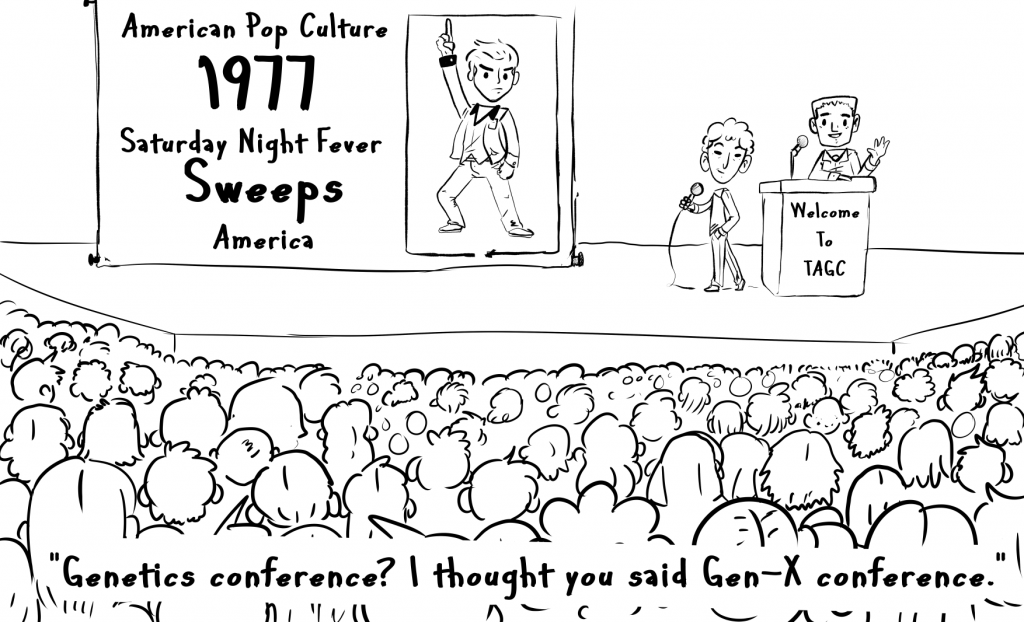 The Allied Genetics Conference – TAGC – is coming up soon (July 13 to 17 in Orlando), with an abstract submission deadline of March 23. This pan-genetics meeting features seven of the GSA communities: C. elegans; Ciliates; Drosophila; Mouse; Population, Evolutionary & Quantitative Genetics; Yeast; and Zebrafish. I think you should be there, because someday you’ll be a lot older.
The Allied Genetics Conference – TAGC – is coming up soon (July 13 to 17 in Orlando), with an abstract submission deadline of March 23. This pan-genetics meeting features seven of the GSA communities: C. elegans; Ciliates; Drosophila; Mouse; Population, Evolutionary & Quantitative Genetics; Yeast; and Zebrafish. I think you should be there, because someday you’ll be a lot older.
TAGC is your own individual community meeting (with its invited speakers and award winners) as usual, plus joint sessions with everyone else. You can turn up at any session you like. But you may not appreciate one of the main reasons for attending TAGC until some time has passed: like at least a couple more decades.
 Of course I’ll tell you that we have a dazzling array of speakers – including Cori Bargmann, Francis S. Collins, Jennifer Doudna, and Svante Pääbo – who will give keynote lectures; that you’ll learn the latest technologies; that you can go to sessions on your favorite biological process – in several different organisms; that there will be individual meeting workshops as well as joint workshops on topics like CRISPR technology. But grad students and postdocs: you probably won’t fully appreciate what you get from being at TAGC until you’re into your fifties.
Of course I’ll tell you that we have a dazzling array of speakers – including Cori Bargmann, Francis S. Collins, Jennifer Doudna, and Svante Pääbo – who will give keynote lectures; that you’ll learn the latest technologies; that you can go to sessions on your favorite biological process – in several different organisms; that there will be individual meeting workshops as well as joint workshops on topics like CRISPR technology. But grad students and postdocs: you probably won’t fully appreciate what you get from being at TAGC until you’re into your fifties.
TAGC will have mentoring luncheons, “next stage” mixers where grad students talk to undergrads and postdocs talk to grad students, and editors presenting the ins and outs of journals. Panel discussions will focus on women in genetics, and bootcamp workshops on finding a job, obtaining funding, and getting published. Career coaches will give advice, provide interview tips and critique your CV. But you may be closer to the end of your career than its beginning when you most appreciate TAGC. Here’s why.

Not long ago, a bunch of my buddies came out to Seattle to help me celebrate one of my “big” birthdays (my 60th). About half of them – as you might expect – were people I had worked together with in the same lab or the same department, going back to my graduate student days. Sharing a few years of lab time with someone is like being adopted by a new family living in a tiny apartment, and it hardly seems surprising that some of these people become lifelong friends.
But the other half were people I had met through attending meetings – in my case, principally the GSA-sponsored Yeast Genetics Meeting. So think about that a second: why did these biologists troop out to the Northwest to attend my birthday party when they had never worked in the same place as me? Were those old yeast meetings so wild that the mere thought of them years later induced these folks to give up a couple of days to celebrate with me? Not quite.
One of these buddies, whom I first met at a yeast meeting, ended up collaborating with me on several projects that led to multiple publications. Another later wrote with me both a spoof on genomic nomenclature that appeared in a surprising venue, as well as a book on genetics for the general public. Yet another was my predecessor as president of a science society and taught me the ropes. Still another who accepted the birthday invite organized a national meeting, with me as co-organizer and successor. And so on.
People I got to know at yeast meetings ended up being as close as labmates and came to interact with me at many scientific and personal levels over a span of many years. The science meetings we go to include a lot of people just like us, with similar passions and energies and visions. When we first encounter some of these people – in person rather than in silico – we realize that we’d like to spend more time with them and take on new challenges together.
So now when I go to scientific meetings, I enjoy the talks, the poster sessions, the workshops – all essential to keep us up to date in our field. But even more, I enjoy seeing old friends again and making new ones, because some of these old friends came to be among the closest I’ve ever made.
Now, you might not stay in your career with the organism that attracts you to TAGC – maybe you’re a Drosophila developmental geneticist who later moves into human neurobiology, or a mouse geneticist who ends up in a pharmaceutical company. And some of those kindred spirits in the fly or mouse community you get to know at TAGC may themselves change research fields or come to focus on education or journalism or public policy.
But these career changes won’t matter: when it feels like a good match, you might find yourself 30+ years in the future inviting that someone to a birthday party. And reminiscing at the party about how you came to know each other in Orlando.
For another take on the wonders of Orlando in July, check out my lab’s spoof video for #IAmGSA at https://genestogenomes.org/next-to-a-fern-iamgsa/






























